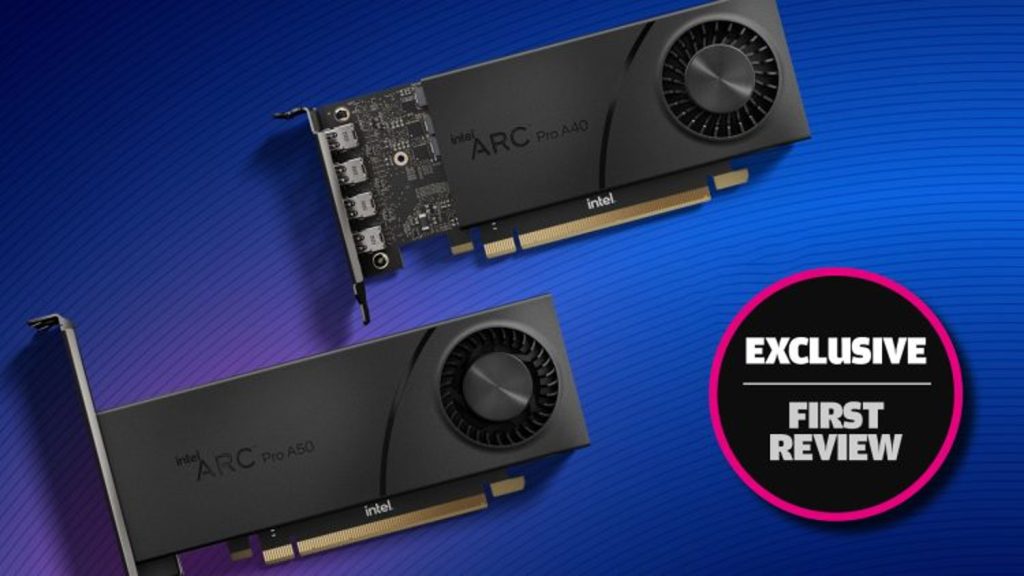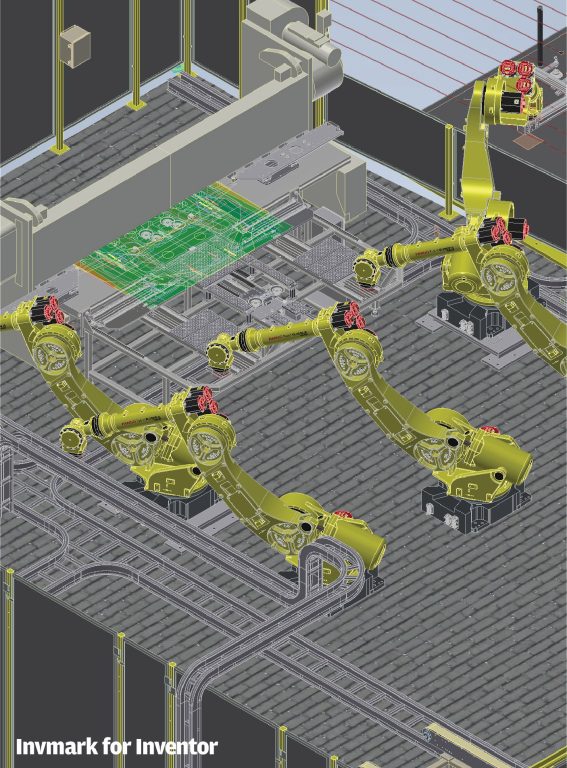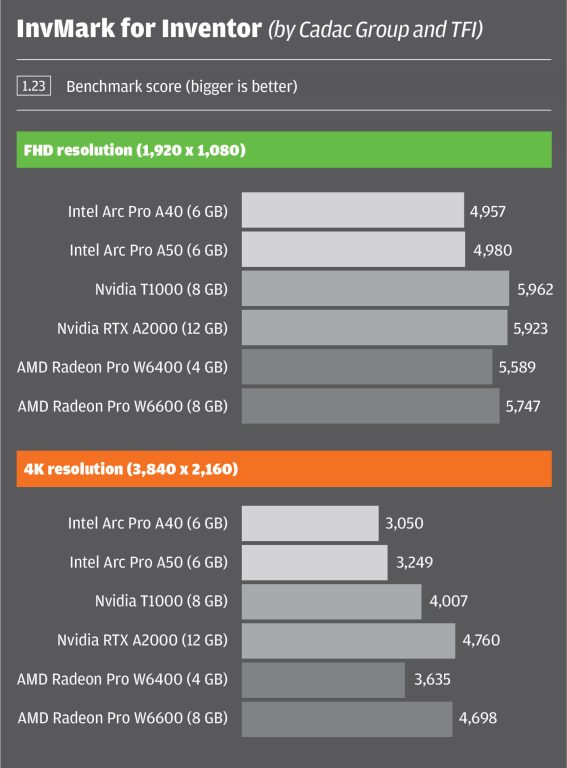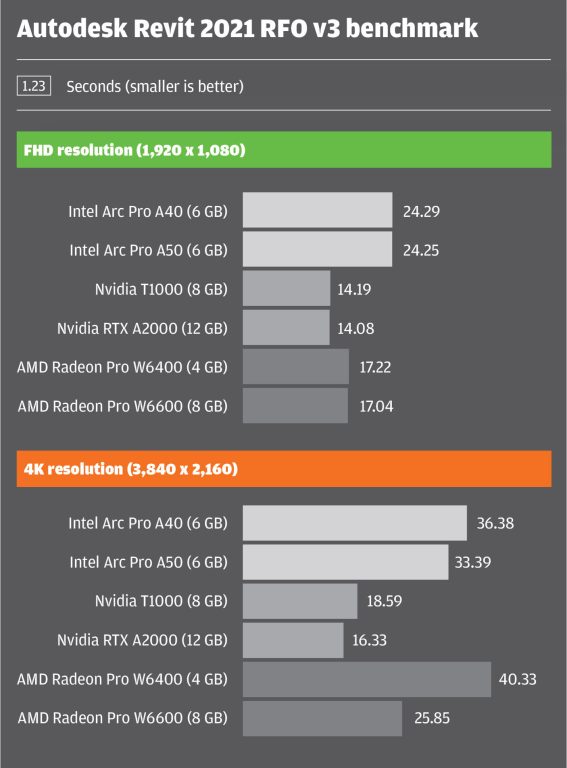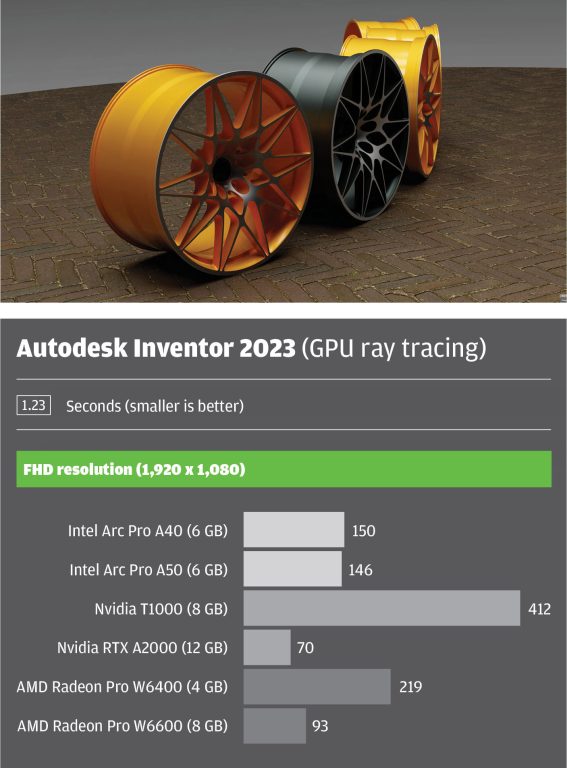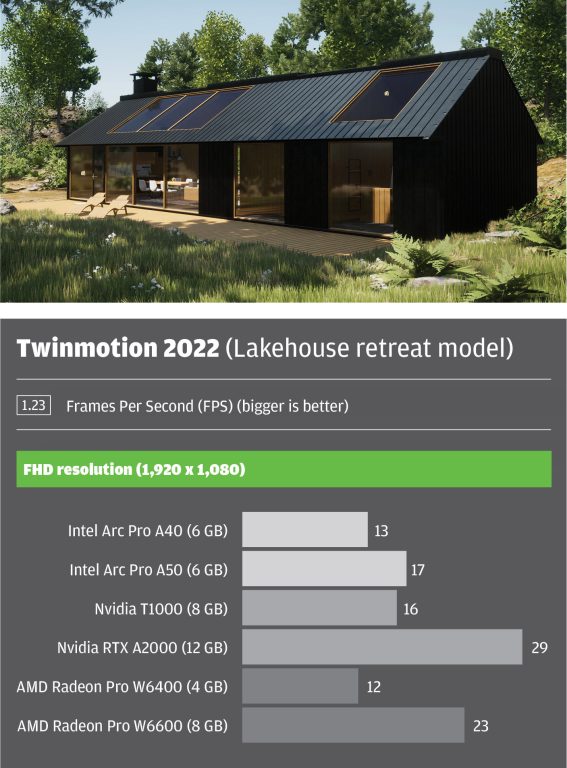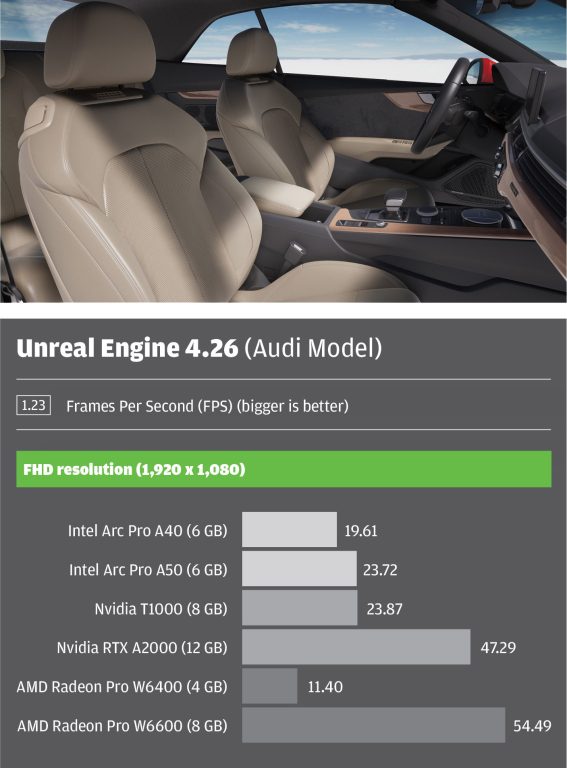Intel’s long awaited discrete pro graphics cards, the Arc Pro A40 and A50, have finally arrived, targeting CAD and BIM workflows. But do these entry-level workstation GPUs have enough to upset the apple cart? Greg Corke explores in this exclusive review
For years, AMD and Nvidia have been the only manufacturers of discrete workstation GPUs – by which we mean graphics cards that plug into a workstation motherboard and are not built into the CPU. But with the launch of the Intel Arc Pro A-series two players have now become three.
Competition is always good, and with Intel’s first-generation pro GPUs — the Intel Arc Pro A40 (6 GB) and Intel Arc Pro A50 (6 GB) — the battle is at the entry-level. And as Intel eases its way into discrete graphics with the first products from its ‘Alchemist’ GPU architecture it makes perfect sense to address this volume market.
A huge part of the entry-level pro graphics market is for workstations that run 3D CAD and Building Information Modelling (BIM) software. Applications including Autodesk Revit, Autodesk Inventor, Graphisoft Archicad and others, are largely CPU limited. This happens when the CPU becomes the bottleneck and is not able to keep up with the graphics card. As a result, no matter how much graphics processing power you throw at a 3D CAD model, frame rates will only increase by a relatively small amount. In some cases, they will not increase at all.
The Arc Pro cards
The Intel Arc Pro A40 and Intel Arc Pro A50 GPUs are low profile PCIe 4.0 graphics cards, designed for ultra-compact and small form factor (SFF) desktop workstations, such as the HP Z2 Mini, HP Z2 SFF, Lenovo ThinkStation P360 Ultra, Dell Precision 3460 SFF, and Dell Precision 3260 Compact. However, fitted with a longer bracket they can also be used in larger desktop towers.
Both cards support the major graphics APIs — OpenGL, DirectX and Vulkan. They also have hardware accelerated ray tracing and hardware assisted AI (XMX) capabilities built in. This means they will work with applications that use Microsoft DX12 / DXR and Vulkan ray tracing (more on this later).
The specifications of the two cards are very similar. They both feature 6 GB of GDDR6 memory, four mini-DisplayPort outputs and offer the same memory bandwidth, plus the same number of Execution Units, Xe-cores, Render Slices, and Ray Tracing Units. Both use a motherboard’s PCIe slot as a power source. Neither need an external power connector. The cards are very well built with a minimalist design.
The only notable differences are form factor, Thermal Design Power (TDP) and peak performance. The Arc Pro A40 is a single slot card with 50W of peak power and 3.50 TFLOPs of peak performance, while the Arc Pro A50 is a dual slot card with 75W of peak power and 4.8 TFLOPs of peak performance. Base clock speeds are the same but because the Arc Pro A50 has a higher TDP, sustained clock speeds can go higher.
Intel’s choice of 6 GB of memory appears to be spot on for its intended market. Most true entry-level pro graphics cards, such as the AMD Radeon Pro W6400 (read our review) and Nvidia T600, come with 4 GB. And while most CAD and BIM models should fit comfortably within that, they might struggle with larger models, especially in CAD applications with more modern graphics APIs such as Solidworks. And when there is not enough memory, performance can drop dramatically.
Equipping its Arc Pro GPUs with 6 GB of memory should also build in some level of future proofing. Indeed, next generation graphics engines that use modern APIs like Vulkan and DX12, and have ray tracing built into the viewport, will certainly need more GPU memory.
Here, we are not talking about real time ray tracing, Unreal Engine style, where massively powerful GPUs ray trace render multiple frames per second. Rather, when working on a model in the viewport, an architect, engineer, or designer, will be able to switch to ‘ray traced’ quality by clicking an icon. It won’t be instant, and it probably won’t be as photorealistic as a specialist viz application like V-Ray or KeyShot, but it should offer a relatively quick way of getting a level of visualisation in the viewport that simulates the way lighting and materials interact — at a quality that surpasses that of the current OpenGL and DirectX rasterisation graphics engines used in most CAD software.
Both Dassault Systèmes (Project Romulan for Solidworks) and Autodesk (One Graphics Engine) have demonstrated GPU ray tracing in the viewport. Autodesk has included a pre-release version in Inventor 2023 that uses DirectX Raytracing (DXR) though it’s still early days.
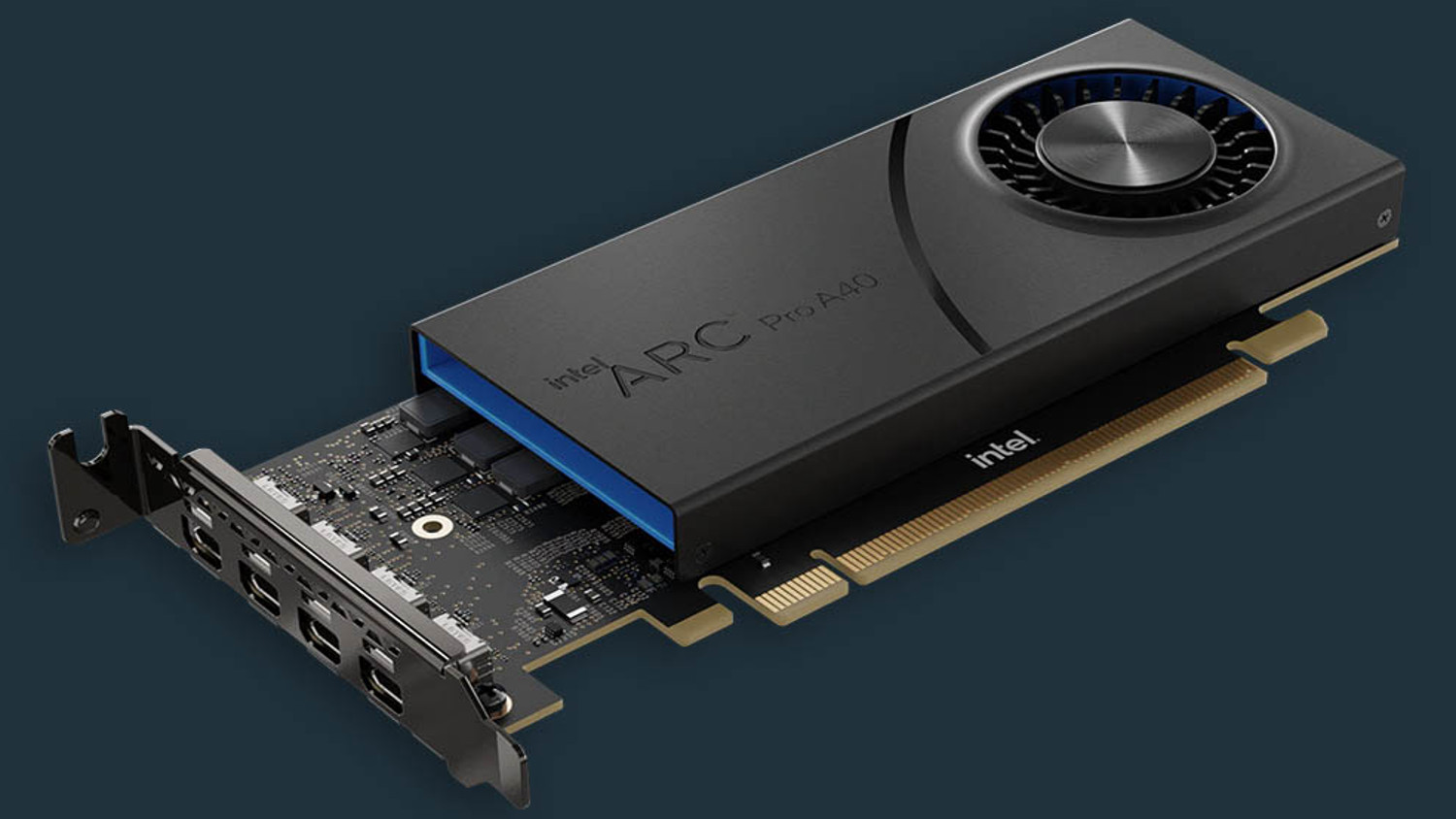
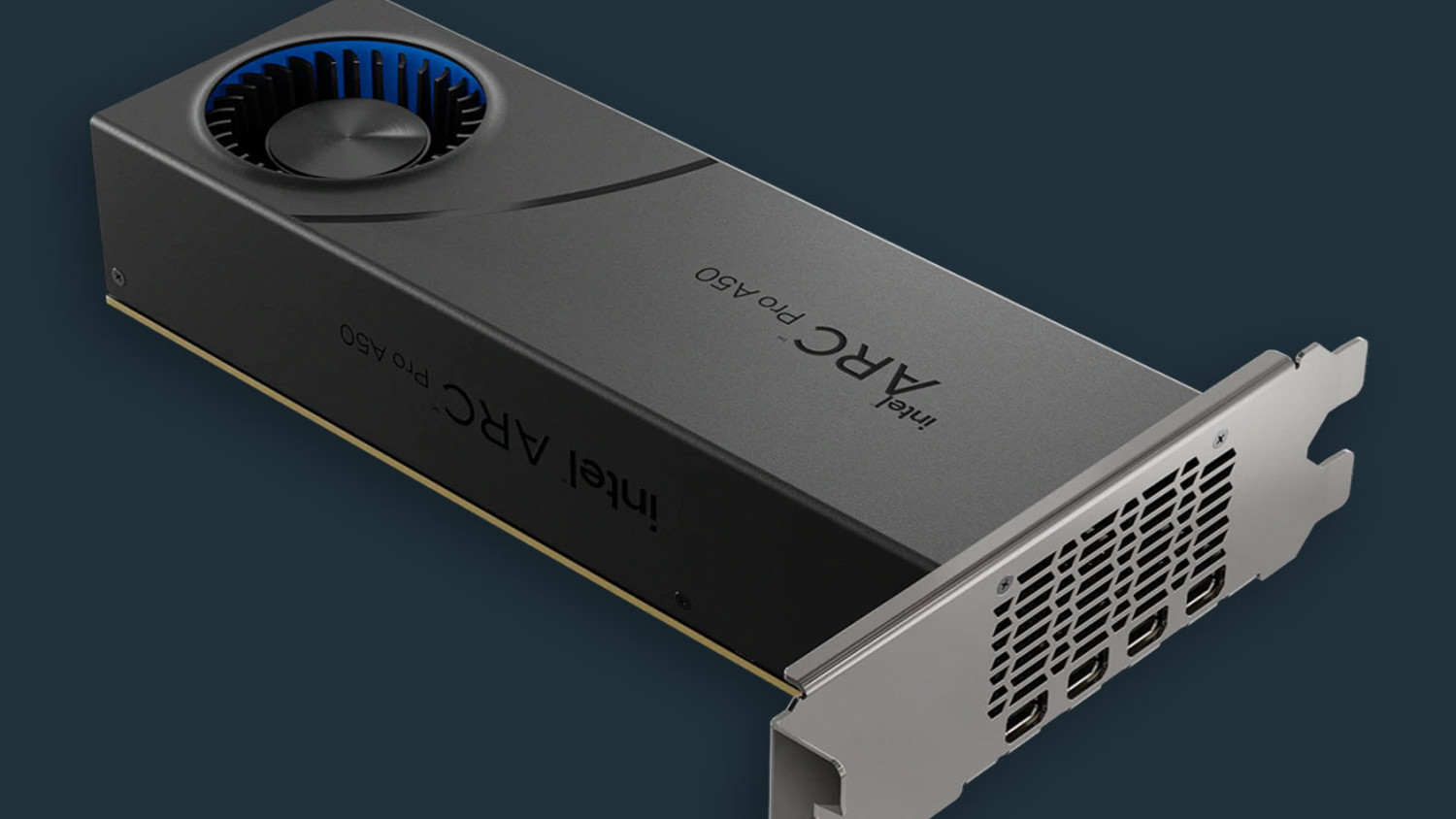
Availability and cost
The new Arc Pro GPUs might be out but are not yet widely available. Intel told DEVELOP3D that the focus is currently on rolling out the products in workstations from major OEMs. You won’t see boxed cards in the channel, for now.
OEMs like Dell, HP and Lenovo frequently introduce new GPUs in line with new workstation launches. And with Intel gearing up for its ‘Sapphire Rapids’ workstation CPUs, and continuing the roll out of 13th Gen Intel Core, the two could align soon.
As the Arc Pro A40 and A50 are not available to buy directly, Intel would not be drawn on pricing. However, Intel sees the Nvidia T600 (4 GB) and Nvidia T1000 (4GB and 8GB) as key competitive products, so the Arc Pro A40 and A50 will need to be priced accordingly. As Intel is new to the world of discrete pro graphics, it will need to shine on value compared to both Nvidia and AMD.
Intel Arc Pro // Drivers and certification
New GPUs aren’t just about new silicon; drivers are an essential part of the package, and pro graphics drivers are what set the Intel Arc Pro cards apart from their consumer counterparts — the Intel Arc A380 and the more powerful Intel Arc A750 and A770.
Intel has a dedicated workstation graphics driver team that works closely with its core driver team, as well as the major Independent Software Vendors (ISVs). In other words, the companies that develop the CAD, BIM and other professional 3D software tools.
Both performance and stability are critical in pro graphics, so the workstation driver team works on optimisations and bug fixes for a wide range of pro applications. Intel says some issues are fixed in its pro graphics driver and others in the applications themselves. The end goal is to get the GPUs certified by each ISV — giving them an official ‘stamp of approval’.
So far, the Arc Pro GPUs are certified for a wide range of Autodesk products, including 3ds max (2021, 2022, 2023), AutoCAD (2021, 2022, 2023), Fusion 360, Inventor (2022, 2023), Maya (2022, 2023). Others include Bentley MicroStation 10.17.00.209, PTC Creo (8, 9), and Siemens Solid Edge 2022 and Nemetscheck Vectorworks Architect (2022,2023).
Certification for DS Catia, DS Solidworks and Siemens NX should come in the next month or two and there are many more apps on the 2023 roadmap, including Archicad, SketchUpand others. The intention is to get both cards certified for at least the two most recent releases of each application.
Of course, Intel has its work cut out here, having to compete with decades of pro driver development from both AMD and Nvidia. It’s a considerable task, especially as many architects, engineers and product designers use multiple applications. But Intel points out that it isn’t starting afresh in terms of ISV relations. Its workstation CPU business has worked very closely with the major ISVs for many years.
Testing Arc Pro
For testing we used the Intel Graphics Driver 31.0.101.3517 for Intel Arc Pro that was released on 5 December 2022. This is just the bare bones graphics driver without the supporting UI. When installing the driver, it’s supposed to automatically pull-down a Pro version of the Intel Graphics Command Centre from the Microsoft Store. However, at time of testing this wasn’t quite ready. Future versions of the driver will be integrated.
We put the Arc Pro A40 and Arc Pro A50 up against a range of entry-level pro graphics cards from AMD and Nvidia. This includes the AMD Radeon Pro W6400 (4 GB), AMD Radeon Pro W6600 (8 GB), the Nvidia T1000 (8 GB) and Nvidia RTX A2000 (12 GB) (thanks to PNY and Scan for supplying the Nvidia GPUs). Of those four cards, the Nvidia T1000 is the only one not to support hardware accelerated ray tracing.
Unfortunately, we were unable to secure an Nvidia T600 (4 GB), which is a shame as Intel considers this to be a key competitor for the Arc Pro A40.
For the workstation we used the Boxx Apexx S4 with an Intel Core i9-13900K. The core specs can be seen below.
Boxx Apexx S4
- Intel Core i9-13900K processor
- 128 GB DDR5-4800 MHz memory
- 1 TB Seagate 530 Firecuda SSD + 2 TB 7,200rpm Hard Disk Drive (HDD)
- ASRock Z790 Taichi motherboard
- Microsoft Windows 11 Pro 64-bit
Intel states the importance of enabling Resizable BAR (Base Address Register) on your motherboard to maximise performance. The technology is designed to allow your CPU and GPU to better communicate with one another over the PCIe bus.
Resizable BAR was already enabled on our ASRock Z790 Taichi motherboard (where it goes by the name of C.A.M). It is supported by most modern motherboards and CPUs, including AMD and Intel, and one would presume by any OEM workstations that come in the future.
Autodesk Revit (BIM)
Revit is a key target application for the Intel Arc Pro A40. It is a leading tool for BIM and notorious for being CPU limited, so there is no real benefit to using high-end GPUs. It uses DirectX 11.
We loaded up a variety of test models, ranging from 30 MB to 200 MB (including linked models), and with the Arc Pro A40 the viewport felt responsive at both FHD and 4K resolution, in shaded and realistic visual styles.
By default, Revit simplifies models during navigation, suspending certain graphics effects, such as shadows. However, even when this was disabled, we got a smooth experience. With some of the larger models, there was a little bit of lag at 4K, but it was still perfectly usable.
To assess relative performance, we ran the RFO 3.1 benchmark for Revit 2021. Here both the Arc Pro A40 and A50 edged out the AMD Radeon Pro W6400 at 4K, but not at FHD. The Nvidia T1000 and Nvidia RTX A2000 were some way ahead.
Autodesk Inventor (CAD)
Inventor is a popular mechanical CAD (MCAD) tool that uses DX 11. For hands-on testing we used a 355MB assembly of a Mastenbroek trenching machine with 1,569 parts. Even when ramping up the quality in the viewport, enabling shadows (ground, object and ambient), reflections and a realistic visual style, navigation was silky smooth with a 3Dconnexion Space Mouse, even at 4K resolution.
Testing for performance using the Invmark for Inventor benchmark both the Intel Arc Pro A40 and Arc Pro A50 came in second to the AMD and Nvidia cards.
CAD-integrated GPU ray tracing
As mentioned earlier, Inventor 2023 includes a pre-release version of a GPU ray tracer that uses DirectX Raytracing (DXR) and hence takes advantage of the Intel Arc Pro’s Ray Tracing Units and, potentially in the future, hardware assisted AI-based upscaling (XeSS). It is designed as an alternative to the current CPU-based Autodesk Raytracer (ART).
In terms of performance there was very little between the Arc Pro A40 and A50, both completing ‘low quality’ FHD renders of a relatively simple model in a very similar time. The Intel GPUs were significantly faster than the AMD Radeon Pro W6400 and wiped the floor with the Nvidia T1000 (8 GB). However, this comes as no surprise as Nvidia’s entry-level GPU does not include dedicated ray tracing hardware, relying instead on its general purpose CUDA cores to crunch the path tracing algorithms. The more powerful and more expensive hardware ray tracing enabled Nvidia RTX A2000 and AMD Radeon Pro W6600 demonstrated a clear lead.
We also tried rendering the considerably more complex Mastenbroek model, but here the question of GPU memory came to the fore. The model alone took 3 GB and enabling GPU ray racing took things well over the 6 GB threshold of the Arc Pro cards. It still rendered, however, and didn’t take that much longer than the simple scene.
Taking things to the next level, the complex factory layout model from TFI’s Invmark benchmark used up over 13 GB of GPU memory (6 GB dedicated and 7 GB shared). It took 2,128 secs to render the FHD resolution ‘low-quality’ scene. In short, while the GPU can be used to ray trace large scenes that far exceed its 6 GB capacity, expect to wait a very long time for the results.
Solidworks (CAD)
Solidworks is one of the most popular MCAD applications and, as a result, one that we often use to test workstation hardware. For its graphics engine it uses OpenGL 4.5, one of the more modern versions of the mature graphics API, and offloads more of the graphics processing to the graphics card which can increase demands on GPU memory.
Graphics certification for Solidworks is not just important for stability and performance. Once a GPU has that ‘seal of approval’ it will unlock special ‘pro’ features in Solidworks such as RealView for more realistic real time shading.
The Intel Arc Pro A40/A50 are not yet certified for Solidworks and therefore performance in the viewport wasn’t great. According to Intel, its GPUs are now in the final stages of Solidworks certification and this should happen soon. When it does, we’ll follow up with some proper testing.
Intel Arc Pro // Design visualisation
The Arc Pro A40 and A50 are very much focused on CAD and BIM workflows, but one can’t ignore the growing importance of real-time visualisation throughout the design process. This is especially true in architecture, engineering and construction (AEC), where tools such as Chaos Enscape, Lumion and Epic Games Twinmotion (powered by Unreal Engine) are widely used.
Before we get into the meat, it’s important to state that the Arc Pro A40 and Arc Pro A50 GPUs are not designed for those who take visualisation seriously. You can pretty much forget about working at 4K resolution. The GPUs simply don’t have enough memory or horsepower to deliver workable frame rates. At 4K resolution even some medium sized models will struggle to fit into 6 GB.
In saying that, there’s no reason why the Arc Pro A50 shouldn’t be considered for CAD-centric visualisation on a FHD display. With one quarter of the pixels to render as 4K, the demands on the GPU are much lower.
Twinmotion (viz)
Since Epic Games acquired Twinmotion and initially gave it away for free, there have been millions of downloads of this easy to use architectural visualisation tool. Autodesk is also now giving it away free with Revit subscriptions.
When testing in Twinmotion 2022.2.3 using DirectX 11, the Arc Pro A50 delivered a respectable 18 FPS with the 6.2 million polygon, 300 object ‘Lakehouse retreat’ demo scene, which includes a relatively simple 3D model but tonnes of vegetation. On the flip side, a bare bones 3 million polygon 120 MB Revit model linked via Datasmith, delivered 27 FPS, but performance would naturally decrease as entourage is added. From our testing, the Arc Pro A50 had the edge over the Nvidia T1000. The Arc Pro A40 was notably slower, which is not surprising as, unlike CAD, Twinmotion is GPU limited so can take full advantage of the Arc Pro A50’s superior raw performance.
Twinmotion can also be used with DirectX 12, which also adds support for path tracing. Flipping into DirectX 12 mode boosted performance a little but it also increased memory usage. We then enabled the path tracer to render out a scene. While this worked, it made the viewport very choppy and hard to navigate. However, if left alone to do its thing, it delivered some nice results, fairly quickly. For this to work in practice, you’d need to frame your scene first and then enable path trace mode.
One word of warning, however. When enabling DirectX 12, we were cautioned that our config may be too limited to support path tracing properly and we ‘might experience instability’. We didn’t experience any problems ourselves but imagine the warning could be related to the risk of running out of GPU memory.
Enscape (viz)
Enscape is a fantastic tool for real-time visualisation and one that is hugely popular with architects. It uses the Vulkan API and elements of ray tracing for real-time rendering.
Initially when testing Enscape with some Revit scenes and executables, the software crashed. When we raised this with Intel, we were told the pro driver team was already aware of the issue, having identified some problematic Vulkan code in Enscape. According to Intel, the two companies worked together to resolve the problem. In just two weeks, Enscape updated its software so it was ready for the 3.5 preview release, and Intel then fixed its driver.
To see this in action we got the system running stably with Enscape 3.5 preview and the forthcoming Intel Arc Pro 31.0.101.4079 driver (currently in pre-release) but with time constraints that’s about as far as we got. Because we were working with beta software, and the AMD and Nvidia GPUs were all tested with Enscape 3.1, we were unable to make a direct performance comparison.
Unreal Engine (viz)
Unreal Engine needs little introduction. As well as being the world’s leading game engine, it’s making huge strides in design visualisation, in both AEC and automotive. While we wouldn’t recommend that anyone use the Arc Pro A40 or A50 for creating real time experiences in Unreal Engine, testing the GPUs with the engine does give a good indication of where their performance lies and what a consumer of Unreal Engine real time experiences might expect. At FHD resolution, the Arc Pro A50 was on par with the Nvidia T1000 (8 GB).
Memory
Intel’s choice of 6 GB certainly hits the sweet spot for most CAD workflows. In Revit and Inventor, you’ll be very hard pushed to find a model that won’t fit comfortably within that envelope. With Solidworks, the memory requirements are a bit bigger, but the Arc Pro A40 and A50 should still be able to handle most small to medium-sized assemblies once the optimisations and certification are sorted.
As you move into design visualisation, however, GPU demands can rise considerably, especially when using a real-time viz tool alongside your CAD/BIM tool of choice. In fairness, the Intel Arc Pro A40 and A50 seemed to handle datasets larger than 6 GB quite well when the system was left alone for ray tracing, but, as you would expect, less for real time navigation, where frame rates dropped dramatically and viewports became choppy. Here an 8 GB or 12 GB card would make a big difference.
One observation was that the Arc Pro GPUs appeared to use more memory than GPUs from AMD or Nvidia when loading the same datasets. With the Lakehouse retreat model in Twinmotion, for example, the Arc Pro A50 used around 5.2 GB whereas the Nvidia T1000 used around 1 GB less. So, while the Arc Pro A40 and A50 give you 2 GB more than other entry-level pro GPUs – the AMD Radeon Pro W6400, Nvidia T400, Nvidia T600 and Nvidia T1000 (4 GB) – the difference in usable memory might not be as big.
Conclusion
It’s great to see a new player in pro graphics, and they don’t come much bigger than Intel. Competition is good for everyone. It helps bring down prices and encourages innovation. And Intel knows this better than most, with AMD continuing to push Intel hard in CPUs.
But entry-level pro graphics is a different beast entirely. It’s not just about who has the fastest GPU and raw performance. It’s about channelling those resources to get the most out of CPU-limited CAD software, ensuring stability and that 3D geometry, materials, lighting and UIs display correctly.
From what we have seen from our testing, Intel has made a solid, if not remarkable start to its journey — and it will be a journey. Our experiences in Revit and Inventor with the Arc Pro A40 were good and with Twinmotion and Unreal Engine we saw how the Arc Pro A50 can even be used for entry-level visualisation at FHD resolution.
But there will be bumps in the road. Fixing problems is all part of pro graphics, AMD and Nvidia included, and while it’s good to see Intel being very active here — Enscape being a case in point — it will take time to build trust among users.
Certification will certainly help. Arc Pro GPUs are already certified for many of the major 3D CAD/BIM tools, but there are plenty missing. And while certifications for DS Solidworks, DS Catia, Graphisoft Archicad, Siemens NX and SketchUp should come soon, there are many complementary tools, covering visualisation, simulation, CAM, reality modelling, Product Lifecycle Management (PLM) and more.
With workflows that rely on a broad set of applications, designers, engineers, and architects want all bases covered. AMD and Nvidia have pro certifications that run into the hundreds, so Intel certainly has its work cut out here.
But there’s little point in judging Intel on that quite yet, as Arc Pro desktop GPUs are not yet really available. This should come next year when workstation OEMs launch new machines based on 13th Gen Intel Core and Sapphire Rapids processors.
Putting application certifications aside for one minute, from a pure hardware standpoint, the Arc Pro A40 / A50 compare favourably to the competition. They have 2 GB more memory than the AMD Radeon Pro W6400, Nvidia T600 and Nvidia T1000 (4GB), which should be to their benefit in more GPU-hungry CAD applications and for entry-level visualisation. Also, Nvidia’s T-Series GPUs do not include hardware ray tracing.
But all of this could change, of course. With AMD and Nvidia recently launching new GPU architectures (AMD RDNA 3 and Nvidia Ada Lovelace) we wonder if we might see new entry-level pro GPUs from both vendors at some point in 2023. And while AMD has already included hardware ray tracing with its entry-level pro GPUs, there’s every chance Nvidia will do the same for its next generation.
And this leads us on to the important question of how much the Arc Pro A40 and A50 will cost. Intel will certainly need to be aggressive on price to entice people away from tried and tested Nvidia and AMD solutions. And as IT budgets are squeezed, this could make a big difference. But we’ll have to wait a little while for that, to find out which OEMs have taken on the products and in which workstations.
Intel Arc Pro for mobile workstations
Intel has a third member of its pro graphics family, the Intel Arc Pro A30M. Designed for mobile workstations, this entry-level GPU has similar specs to the Arc Pro A40 but has 4 GB of memory and a slightly lower peak power rating of 35-50 watts.
Lenovo is the first major workstation OEM to take on the product, offering it as an option inside the ThinkPad P16 Gen 1.
Choosing the Intel Arc Pro A30M (4 GB) instead of the Nvidia RTX A1000 (4GB) will take £183 off the price of the machine.
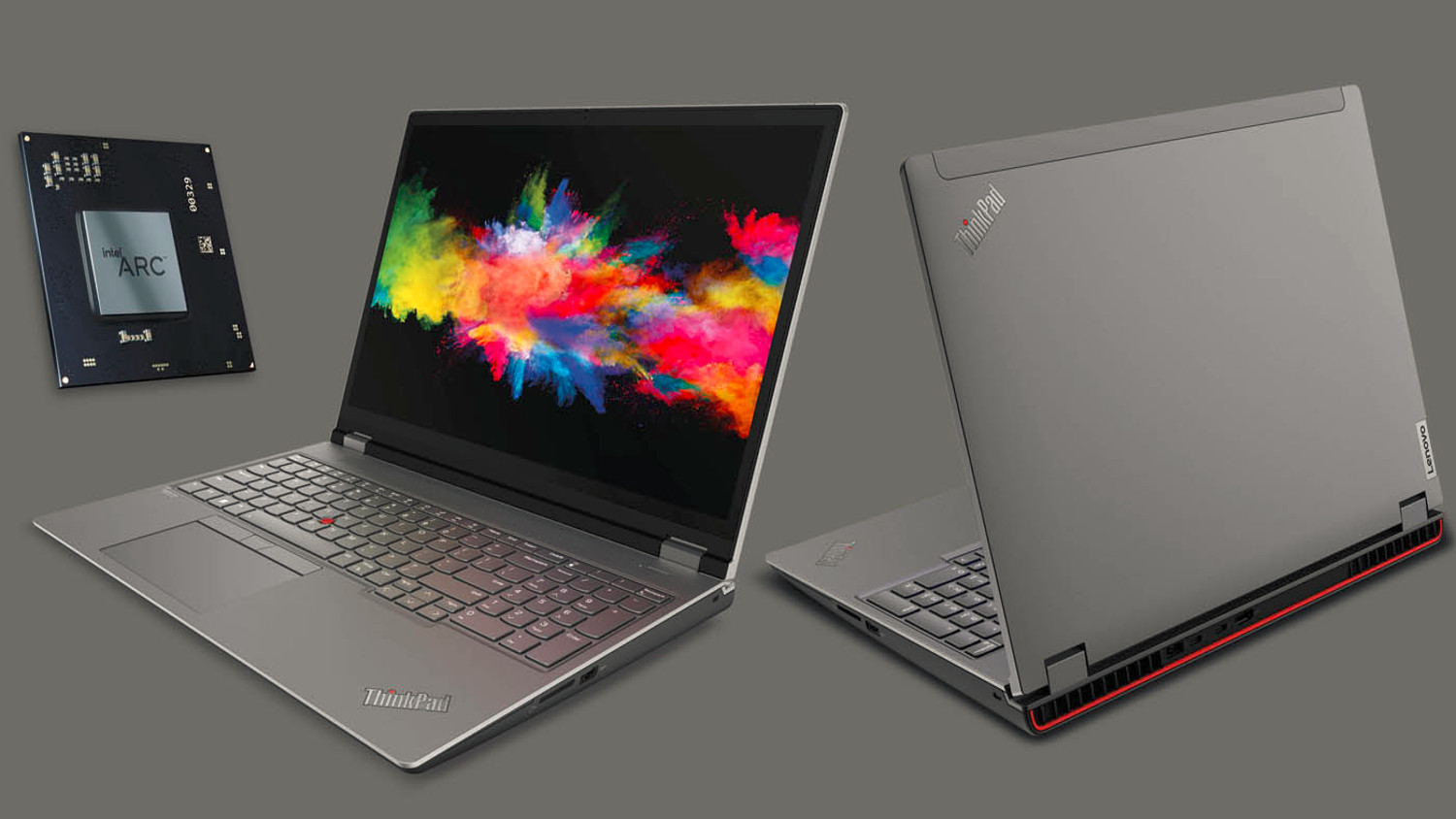
This article is part of DEVELOP3D’s Workstation Special Report
Scroll down to read and subscribe here.
Featuring
- Review: 13th Gen Intel Core vs AMD Ryzen 7000 CPUs
- Comment: Workstation energy efficiency
- Review: Scan desktop workstations
- Review: Boxx Apexx S4.04 workstation
- Review: HP Z2 Mini G9 workstation
- Review: Armari Magnetar M64TP-RW1300G3
- Review: Dell Precision 5470 mobile workstation
- Round-up: Ultra-portable mobile workstations
- Review: Nvidia RTX A2000 / Nvidia T1000 GPUs
- Review: AMD Radeon Pro OpenGL driver

